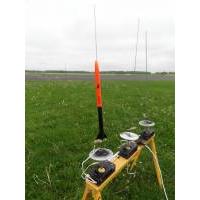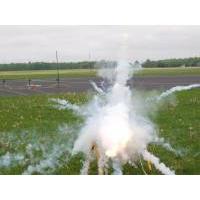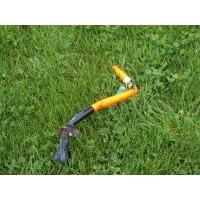| Construction Rating: | starstarstarstarstar |
| Flight Rating: | starstarstarstarstar_border |
| Overall Rating: | starstarstarstarstar_border |
| Published: | 2016-03-14 |
| Manufacturer: | Scratch |
 Brief
Brief
I'm always on the lookout for vintage rockets on Ebay. Something about continuing the career of old veterans appeals to me, and I picked up several mystery birds from a collection back in the summer of 2012. The only notation on the rocket in question was "Mach Buster", so after receiving them, I started checking through the catalogs on Ninfinger to see what I had, and it didn't take long to find that one was an FSI Dart. While I found that cool enough, the discovery of a live FSI A4-4 that had been a part of a display base really made made me take notice. I've yet to fly this old vet, but I plan to, and on that A4-4.
Realizing that the Dart wouldn't accept modern 24mm engines because of the oddball FSI tube tolerances, I decided to build a clone using a Semroc cone and BT-50 tubing. In keeping with the spirit of the original, I painted it flourescent orange and black, and even printed up a black variation of the original decal.
Components
- BT-50 body tube
- BNC-50KP nose cone
- CR-2050 engine block
- 18" Kevlar shock cord
- 18" sewing elastic shock cord (1/8")
- medium screw eye
- large snap swivel
- 36" plastic streamer
- 3/32" basswood fin stock
Construction
The Dart is the very soul of a 3fnc kit, and as such construction is a simple matter of printing off a fin attachment guide and making sure the small fins go on straight. I installed the engine block at the depth to accept Estes E9 motors and tied a length of Kevlar around the centering ring before gluing it in place. Fins were cut out of 3/32" basswood fin stock and attached with Titebond II wood glue.
Finishing
Since the original Dart had been painted flourescent orange and black, it made picking the colors a no-brainer, something that I'm particularly well suited to handle. The Semroc nose cone and basswood fins needed only to be primed and skimmed with a light coat of thinned Elmer's Carpenter's Wood Filler, then sanded lightly to be considered finished well enough for my tolerances. Rustoleum Midnight Black Metallic was used for the bottom half while the top half got the flourescent orange look courtesy of my no-name can of flourescent from ten years ago or more. The decal that was with the instruction scan at YORS http://plans.rocketshoppe.com/fsi/fsiMRK-XVII/fsiMRK-XVII.htm had DART in black with a red bird holding a lightning bolt. I had no idea what the bird had to do with a dart, but after changing the color of the bird to black and printing it on inkjet decal paper, it fit in well with my inherited color scheme.

Flight
I missed several opportunities to fly the Dart at the TORC cornfield, so I took it along for a Saturday launch with ROCI at the AMA Field in Muncie, Indiana. Had it been a normal day of launching, I probably would have looked outside then gone back to bed, but I was at flight #995 and wanted to make #1000 with my recently completed Estes Pro Series Ventris, and needed a field that would hold it. The Dart was the fourth bird to the pads for me that day, or #999 if you're keeping score at home. I had an Estes E9-8 that I wanted to use with it, hoping to get an idea of what it was like back in the FSI days of big motors and minimum diameter rockets. I got that idea, and more.
My first flight of the day had been a massive CATO on an E9-4 that completely destroyed my Estes Rascal upscale on its maiden flight, but three flights later I had shaken that disaster off as the luck of the draw. Surely I wouldn't be targeted by the rocket gawdz twice in the same day, right? The E9-8 had been with me for a long time. It had a 2004 date code on it, but I didn't hesitate at all and loaded it in the Dart. I took some on-pad glamour shots, walked back from the flightline and wait for the launch, very much anticipating a cool liftoff pic.
Unlike the Rascal, which detonated when it was fifty feet off the pad, the Dart did me the honor of blowing up as soon as the button was pushed, which allowed me to get one great shot of the fireball before I flinched and quit shooting. The nozzle blew out and hit the blast deflector while the rest of the force propelled the rocket off the pad, only after blowing a hole through the body tube just above the centering ring. The launch rod and deflector were blown into the grass ten feet to the left of the pads. The rocket itself continued heading up to the 100' level, then returned nose down to bury itself in the soft earth. There was a moment of shocked silence before everyone headed out to see the carnage. The Dart looked like the T-1000 after Ahnald served it a snack from the grenade launcher. The airframe was nonexistent in the area between the fins and the engine block, which was also nonexistent. The Kevlar that had been tied to it was still there, but the cardboard ring itself was gone. The ballistic recovery had resulted in a kinked tube below the nose cone, which, along with the Kevlar, elastic and streamer, turned out to be the only parts salvageable. Well, the fins could have been salvaged, but I felt like they'd already been through enough.

After a complete rebuild that centered around the salvaged nose cone, the Dart finally flew, really flew, at NARAM 55. I had another E9-8 marked for use on what I thought would be a big field, but the combination of tighter than expected conditions and increasingly boisterous late afternoon winds caused me to rethink the big 24mm. I opted for a C11-7 instead as I was also out of D12-7s. The flight was uneventful, but it was good to have a successful one after the rather "tough on the airframe" first flight. It topped out at an estimated 750' and recovered without incident up the field toward the competition tent.

Summary
Pros: Vintage mach-buster lines. FSI mystique. Quick and easy build for a great performer
Cons: FSI still seems dead in the water.
Related Products
Sponsored Ads
 |
 |















